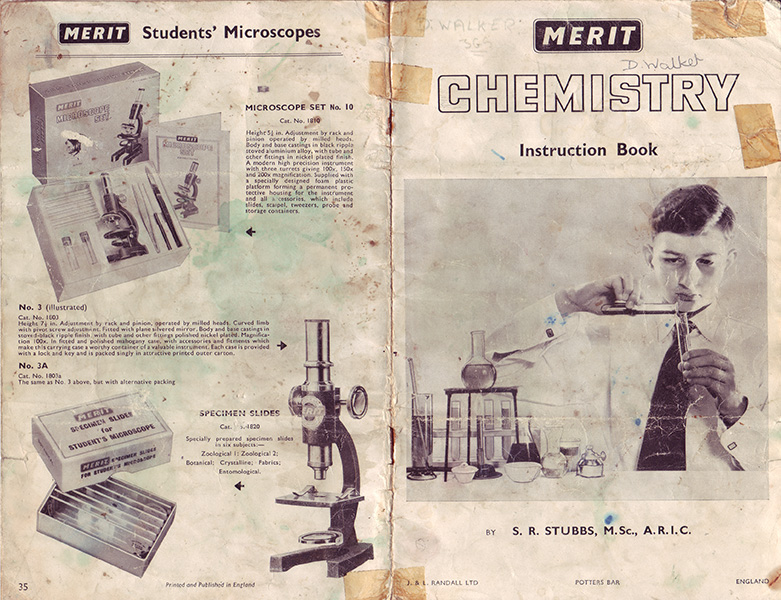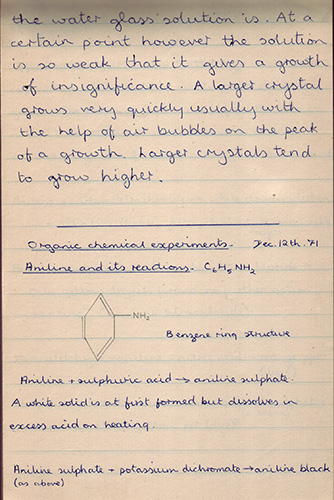As it's our 20th anniversary issue of Micscape, a reflective mood seems acceptable so offer some admittedly self-indulgent jottings on how two toys received when I was about twelve, influenced one of my main hobbies and also my career. I can't recall now whether an interest in science prompted my parents to buy on following birthdays a toy microscope and chemistry set or if the interests were a result of having the toys. Either way I am eternally grateful to my parents for buying them both and for the support they have always offered.
Early microscopy and a lifetime hobby
As remarked in Alejandro Arriaga's interview of my colleague Mol and myself, I no longer have my first microscope. I gave it to a charity shop 20 years ago hopefully for another youngster to enjoy. But do recall that it was quite a good size and robust, with coarse focus only, a mirror and three objectives ca. 50 - 300X. The optics were good enough to encourage rather than deter an interest with a not too ambitious highest magnification. As Guido Santacana has splendidly shown in his articles on toy microscopes e.g. 'A Legacy of Microscopy for Kids' some maker's toy microscopes were well made with competent enough optics. My example was similar to the green Tasco in Guido's article but without the fine focus and with a mirror rather than bulb.
Like many budding microscopists I looked at anything and everything but quickly homed in on the amazing variety of freshwater microscopic life.

Three books that I still have which introduced me to the world of microscopes and microscopic life.
'The Young Specialist Looks at Pond Life' by W Engelhardt translated by Heather J Fisher, Burke, 1968 (1964 1st English print). This was a more in-depth book than the Observer's book with excellent line drawings of typical species for each group.
The Observer's series, published by Frederick Warne & Co. Ltd. in the UK, were affordable books on a wide range of topics. The 'Pond Life' book (1st published 1956) was written by the noted naturalist and writer on freshwater life John Clegg. A celebration of this book has been shared before in May 1998 'A little gem 'The Observer's Book of Pond Life''.
The 'Hamlyn All Colour Paperbacks' were a series published in the late 60s and early 70s and were superb. Peter Healey's 'Microscopes and Microscopic Life' covered a wide range of fundamental and practical aspects of the subject and worth seeking out today. I also had the books on 'Physics', 'Atomic Energy' and 'Chemistry', the latter shown below.
My second notebook of 'Microscope Study' devoted to pond life is shown with entries dating from 1968 when I was 12. I've long lost volume 1.
At the risk of embarrassing myself (it won't be the first or last time), two examples of my rather naive notes and drawings from the booklet aged 12 are shown below.


Above. Rereading the entry, I'm not entirely certain what critter was being described and illustrated. Two distinctly drawn eyes but close together suggest it wasn't a nauplius larvae of a copepod although the drawing shows some similarity to one. Perhaps an immature form of an insect or mite as originally speculated. In the entry that follows it, please excuse the mental aberration of describing an algae as an insect, my taxonomy even at that age wasn't that bad (although I still struggle with the seemingly ever changing classifications of some groups)!


Above. An entry on rotifers. One of the appeals of this group is how a number of species could be found in such unpromising looking (to the beginner) habitats such as birth baths, rain gutter deposits etc. Philodina roseola was the typical species illustrated and described in Clegg's Observer's book so probably labelled it as such for this reason.
My favourite local haunt near my home in Rochford, Essex was the 'brick pond' which recall had a healthy growth of vegetation and enjoyed exploring the area with my brother. We also looked for insects in the surrounding fields. My parents used to take us on outings into the local countryside in the county of Essex. I always carried a few small bottles in my pocket to take samples from any water body large or small that we came across. I also made a plankton net small enough to carry in the pocket.
It wasn't until I was aged 23 in 1979 that I'd saved enough to buy a 'proper' microscope, a LOMO Biolam for £76 by mail order from Youngs of Leicester, a photographic shop where they were typically readily available. I was also drawn to this maker as they were used in my biology practicals at school. I still enjoy using it for 'keeping things simple' microscopy (often the best approach I find for e.g. extreme 'diatom dotting'), but for greater versatility my main compound stand is now a Zeiss Photomicroscope III. My microscopy hobby, as I guess it does for many others, went through fits and starts as education, job and home commitments demanded more time. But the hobby has stayed with me and now retired, it remains one of my main hobbies.

Above. The LOMO Biolam made in 1978 but has been added to over the years with bino' head, aplanatic condenser (shown here) and mechanical stage, plus a range of the more exotic LOMO objectives. The LOMO OI-19 lamp is shown. The lamp was bought shortly after the microscope but was puzzled for many years on why it didn't perform well as a Köhler lamp despite having the key features (albeit with no centering) and after setting up correctly. For a discussion of the lamps limitations and ways to improve, see this Micscape November 2005 article.
Early chemistry, an interest leading to a career
Like many youngsters I was bought a chemistry set, in my case aged about 13. It was a 'Merit' outfit made by J & L Randall Ltd who made a range of science kits. Mine was an intermediate set with a good range of chemicals and a spirit burner. I haven't checked the inventories of modern sets but suspect the range of chemicals are more limited for 'safety' reasons. My set included copper, chrome and cobalt salts and magnesium ribbon. Although do note that eBay has a wide range of sellers of the traditional chemicals in small quantities and apparatus specifically for home chemistry so there's no reason why a good set couldn't be put together today. I've used these suppliers myself for small quantities for microscopy studies of crystals.
I built up the set with chemicals from the chemist and by mail order and as I got older acquired organic chemicals such as aniline for dye studies. Like most youngsters I did make a little gunpowder with potassium nitrate but at that age did know well enough about the dangers of advancing to stronger oxidising agents. I was aged 15 when I started to keep a notebook as shown below with more structured experiments.


Above. Three books from my youth that have kept and which inspired me in chemistry. My notebook far right dates from 1971 when aged 15.
From left to right they are dated 1970 (a reprint, 1st published 1963), 1967 (one of many reprints, 1st published 1949) and 1971. The book 'Chemistry' by John O E Clark was in the same series at the Microscopes and Microscopic Life. The series were full or valuable information but presented in a colourful and lively style.
The book by Heys was very popular going through many reprints. It included experiments on making urea-formaldehyde plastics and I made some crude utensils. Steadily growing large crystals by exploiting the drop in temperature of a house overnight were also presented and tried. I remember growing a potassium aluminium sulphate crystal that was about three quarters of inch long.

Above. Right. Books (e.g. the text shown earlier) and manuals of the time seemed to typically feature this style of earnest hobbyist—possibly to indicate a potential budding professional scientist of the future. I don't recall the typical young lad like myself when experimenting at home wearing a crisply pressed shirt, tie, cuff-links and sporting an immaculate haircut!
Left. Merit also sold microscopes and my sister owned one. But they were rather small, light and less suited than the more robust model I was given. Although Merit did keep the magnifications less than or equal to 200X.


Above. Left. J & L Randall Ltd of Potters Bar made a variety of outfits under the 'Merit' brand. Mine may have been the upper one illustrated. More advanced sets included more chemicals, and apparatus including a bunsen burner—presumably the latter could be connected to the domestic gas mains at the time safely!
Right. As was typical, one manual often served all the sets in a maker's range with restrictions on what could be tried with more basic sets. Books and manuals were invariably written by professionals in science and presented clearly written experiments to give a good grounding in a range of chemical principles.

Above. Left. Detail from the Merit manual. A wide range of accessories were available. I recall the glassware was thin and delicate so likely made of soda glass rather than a typical borosilicate glass of professional laboratory glassware. In the late 60s I remember that Boots the Chemist in the local town of Southend on Sea had a glass cabinet at the back of the shop were this type of apparatus to extend Merit chemistry sets was displayed. Such support for the local aspiring chemist is now long gone on the high street, of course!
Right. Merit also made other science kits to study topics such as physics, electricity and magnetism etc.



Above. An experiment from the notebook studying the effect of sodium silicate solution concentration on the rate of a growth of cobalt (II) chloride crystals to form a 'chemical garden'. This or other metal salts were dropped into the solution and the metal silicates which were deposited formed fascinating colourful plantlike growths. At the time, tins of concentrated syrupy water glass (sodium silicate) could be bought from the local hardware store. It had various uses including preserving eggs. (Wikipedia has an entry for a 'chemical garden' and notes that it formed the basis of experiments on the International Space Station to observe the effect of gravity by comparing growths with the same experiments carried out on the ground.)
My toy microscope started a lifelong hobby and the chemistry set promoted an interest which became my career working in the petrochemical industry—with thanks to my parents for providing such inspiring presents!
The author David Walker welcomes comments.